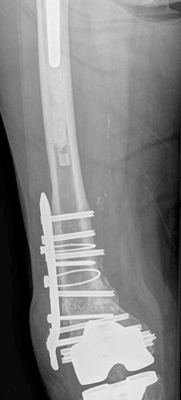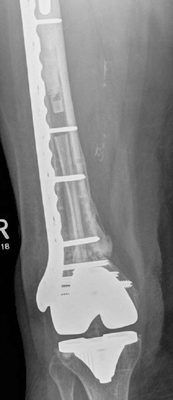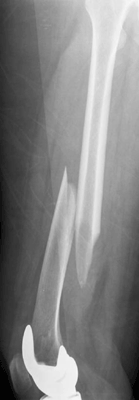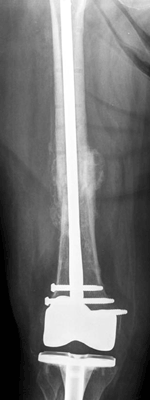Distal femur periprosthetic fracture results depend on selecting an optimal treatment
A thorough work-up and imaging to identify existing implants should precede deciding on an appropriate course of treatment, a Canadian trauma surgeon said.
Statistics show approximately 38,000 cases of periprosthetic distal femur fractures were treated in 2005, according to a traumatologist who told attendees at the 2010 Annual Meeting of the Orthopaedic Trauma Association they play a key part in keeping the incidence of these fractures of the distal femur in check.
He urged his colleagues to do an even better job with these cases by familiarizing themselves with and sticking to the appropriate indications for intramedullary (IM) nails vs. locked or unlocked plates.
“You need to do a good careful work-up — X-rays for sure — and possibly a CT scan. Optimum treatment exists,” Markku T. Nousiainen, MD, FRCSC, said during his presentation at the meeting addressing surgical management of supracondylar femur fractures.
Operative planning
In terms of preventing periprosthetic supracondylar femur fractures, Nousiainen briefly discussed those risk factors that an orthopedist can impact, including providing appropriate osteoporosis management, avoiding significant anterior femoral notching when performing total knee replacement (TKR), and having patients with rheumatoid arthritis discontinue using steroids if at all possible.
|
|
Images: Nousiainen MT |
Once the decision has been made to treat the fracture, he said the next steps are obtaining the original operative notes to confirm which implants the patient already has and classifying the fracture.
“The goals of dealing with these cases are obviously [to] heal the fracture, obtaining appropriate [leg] length, alignment, rotation, a painless, stable knee, and an appropriate range of motion,” Nousiainen said.
Fracture classification
While several classification systems exist, Nousiainen, assistant professor in the Department of Surgery at the University of Toronto, prefers the simplicity of the Rorabeck and Taylor system. It involves fracture types 1, 2 and 3; wherein type 1 is nondisplaced with a well-fixed TKR, type 2 is displaced with a well-fixed TKR, and type 3 is either a displaced or nondisplaced fracture with a loose TKR.
The type and location of the fracture, the patient’s bone quality and general health, and the existence of other femoral implants can influence which treatments are indicated, he said, noting unless a patient is unable to undergo an anesthesia-associated surgery, nonsurgical treatment of supracondylar periprosthetic fractures with a hinge brace is rarely indicated. “Everyone else is an operative candidate” he said.
|
|
|
ORIF technique and implants
There are various open reduction internal fixation (ORIF) options to consider, according to Nousiainen.
“Location of the fracture is key because that is going to determine what sort of implant you can put in there,” he said during his presentation, which focused on treatments for type 1 and type 2 fractures using an IM nail or a plate.
A reliable first choice is a rigid IM nail implanted retrograde. In the literature, these implants are associated with excellent healing rates, acceptable alignment and minimal infection risk, according to Nousiainen.
“They preserve the fracture hematoma. They don’t strip the soft tissue and they provide stability,” he said.
Guidelines for plating
Intramedullary nails are contradicted if the distal interlocking screws of a retrograde nail cannot be placed (due to an insufficient amount of bone distal to the fracture), if an IM implant is already present proximally, such a long-stemmed femoral TKR component, or if, for some reason, the femoral component of a TKR will not accommodate a retrograde IM nail. In those cases, Nousiainen stated that a locking plate is the next best ORIF option, since it provides excellent fixation and better alignment than an unlocked plate.
To obtain optimal outcomes with locked plates, he recommended avoiding stripping the soft tissue envelope around the fracture area and avoiding the use of cerclage wire whenever possible.
But, regardless of the treatment used, “the outcomes aren’t great – these patients have a higher risk of complications compared to non-periprosthetic distal femur fracture patients.” – by Susan M. Rapp
Reference:
- Nousiainen MT. Supracondylar femur fractures: Nail versus plate. Presented at the 2010 Annual Meeting of the Orthopaedic Trauma Association. Oct. 13-16, 2010. Baltimore.
- Markku T. Nousiainen, MD, FRCS(C), can be reached at Sunnybrook Health Sciences Centre, Suite 621, 43 Wellesley St. East, Toronto, Ontario M4Y 1H1; 416-967-8639; e-mail: markku.nousiainen@sunnybrook.ca. He has no direct financial interest in any products or companies mentioned in this article.
Nails and plates can be used with effectiveness to treat periprosthetic fractures. With either appliance, complications (when they happen) can be really awful. Either a fracture proximal to a nail or loss of plate fixation is devastating.
Setting realistic goals is critical. Elderly patients with terrible bone need to get around (not play soccer), find sensible therapists to help and use comfortable braces. Remember, many of these patients are grandparents.
— David Seligson,
MD
Orthopaedics Today Europe Editorial Board
member
Department of Orthopedics
University of Louisville
Louisville,
Ky.
![]() Follow
OrthoSuperSite.com on Twitter
Follow
OrthoSuperSite.com on Twitter




